Abstract
Ligandin (glutathione S-transferase B, EC 2.5.1.18)was treated with p-mercuribenzoate, N-(4-dimethylamino-3,5-dinitrophenyl)-maleimide, 5,5,-dithiobis-(2-nitrobenzoic acid), N-ethylmaleimide, iodoacetamide or iodoacetate. Although performic acid oxidation revealed the presence of four cysteines, p-mercuribenzoate and N-(4-dimethylamino-3,5-dinitrophenyl)maleimide, the most effective of the reagents studied, reacted with only three residues. N-Ethylmaleimide and 5,5'-dithiobis-(2-nitrobenzoic acid) each reacted with two cysteines: iodoacetamide reacted with only one cysteine and iodoacetate was essentially unreactive. Modification of three thiol groups decreased both the enzymic and binding activities of ligandin although the number of binding sites was unaffected. Modification of only one or two of the thiol groups had little effect on the ligandin activities. It therefore appears that there is a thiol group in the common hydrophobic-ligand- and substrate-binding site of ligandin. Ligandin was separated into two fractions on CM-cellulose. Both fractions gave the same results with p-mercuribenzoate and iodoacetamide.
Full text
PDF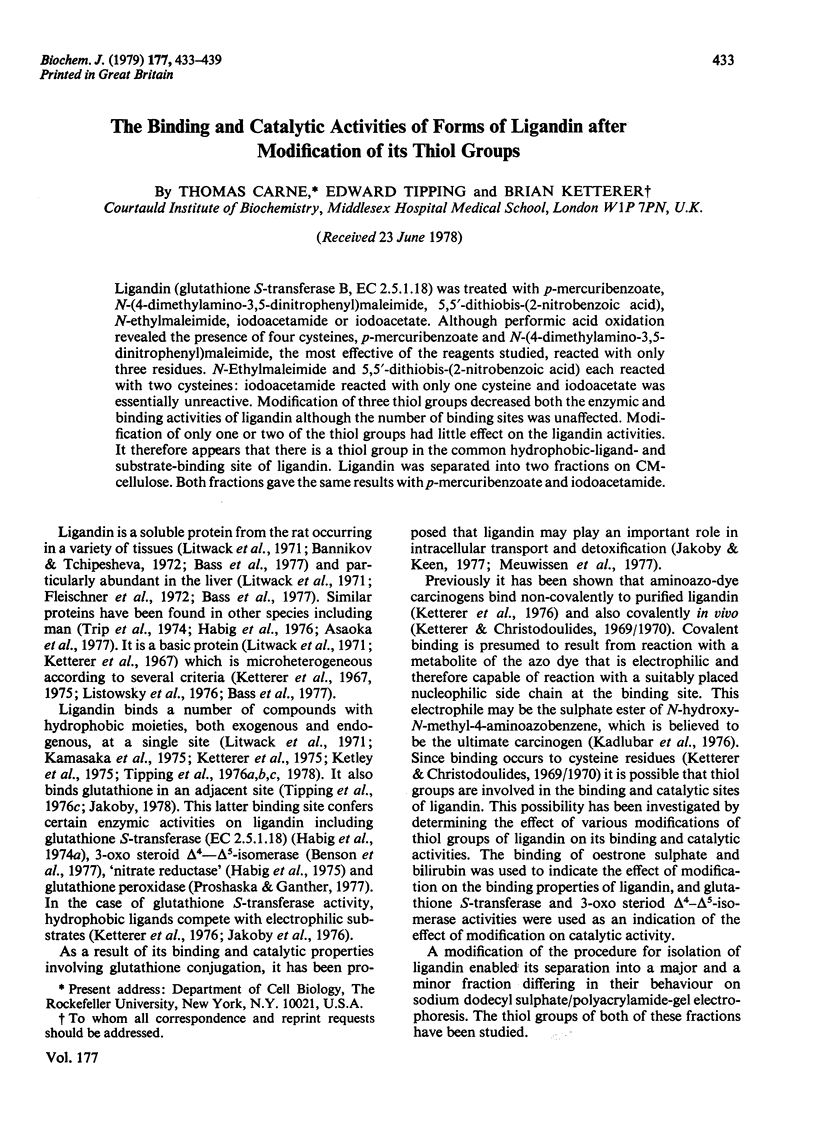
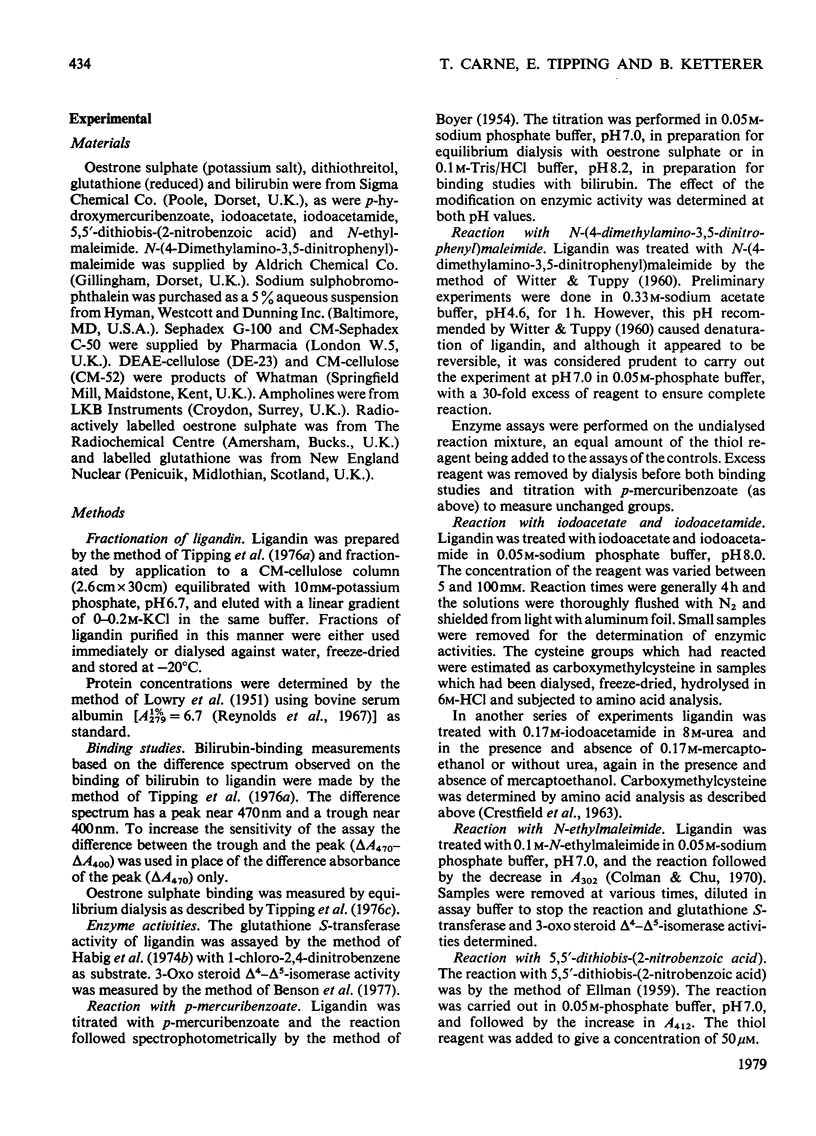
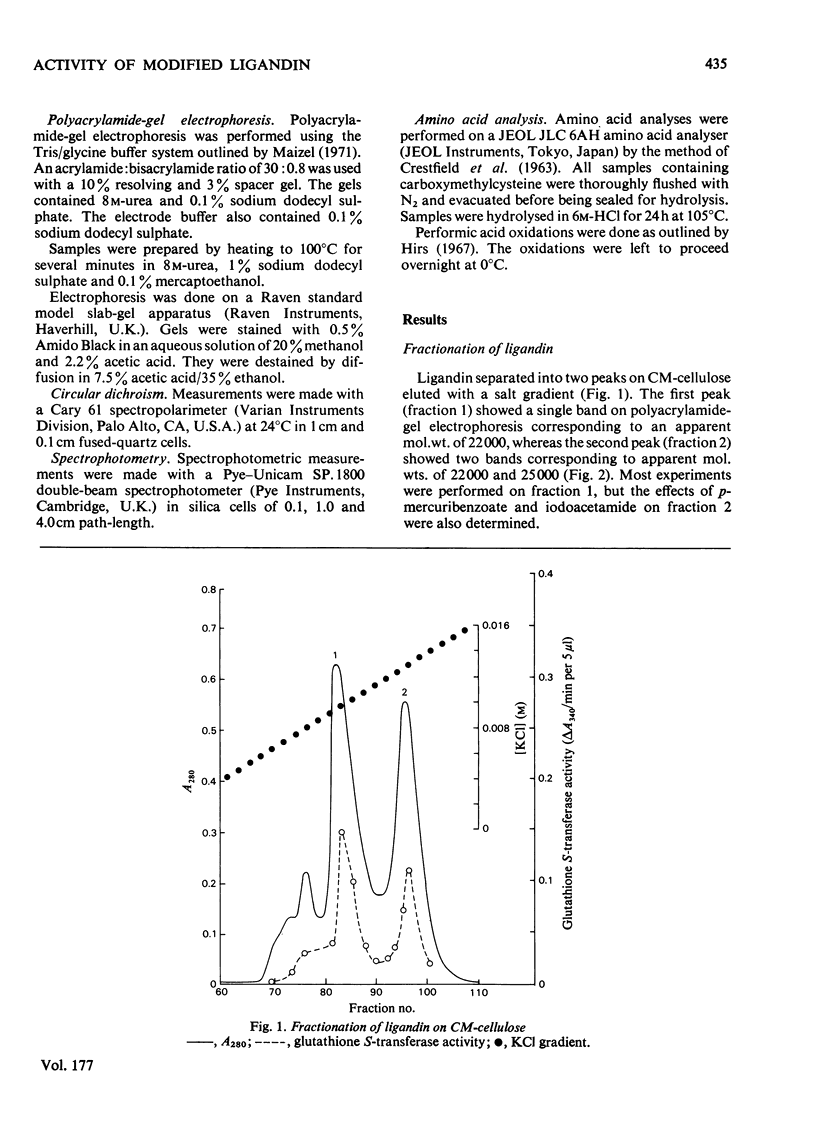
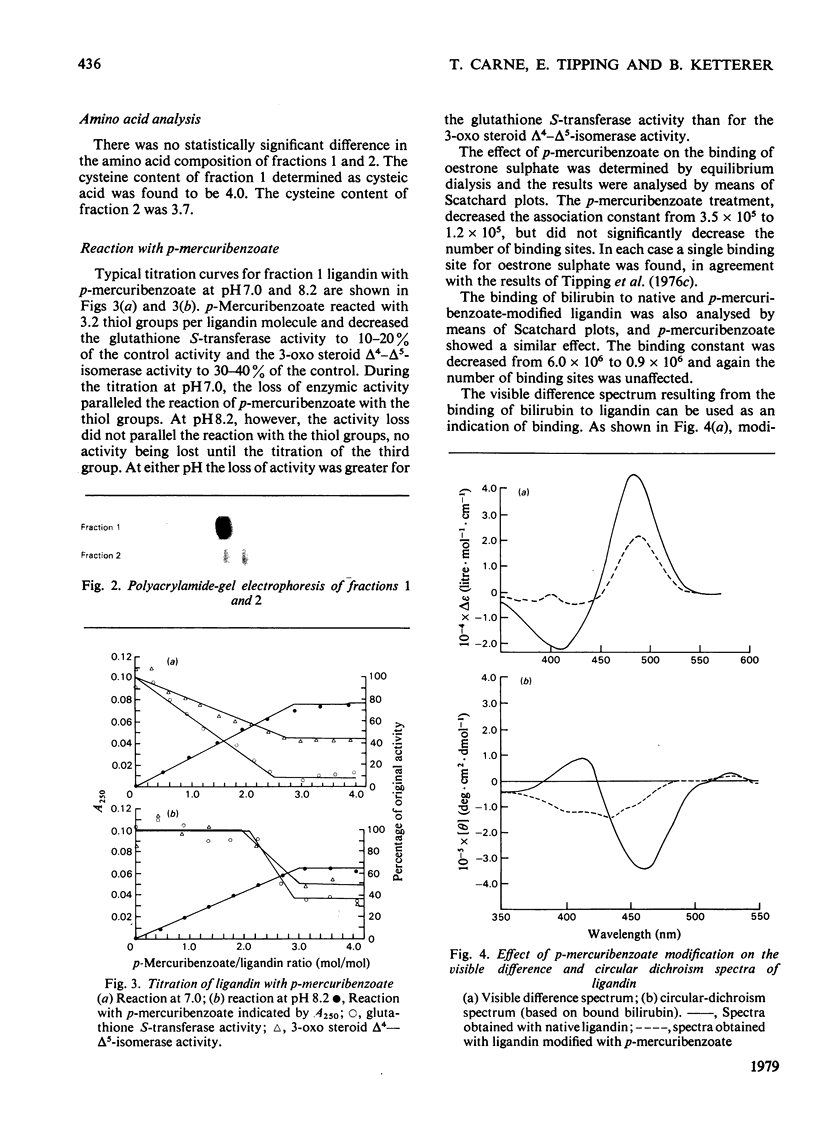
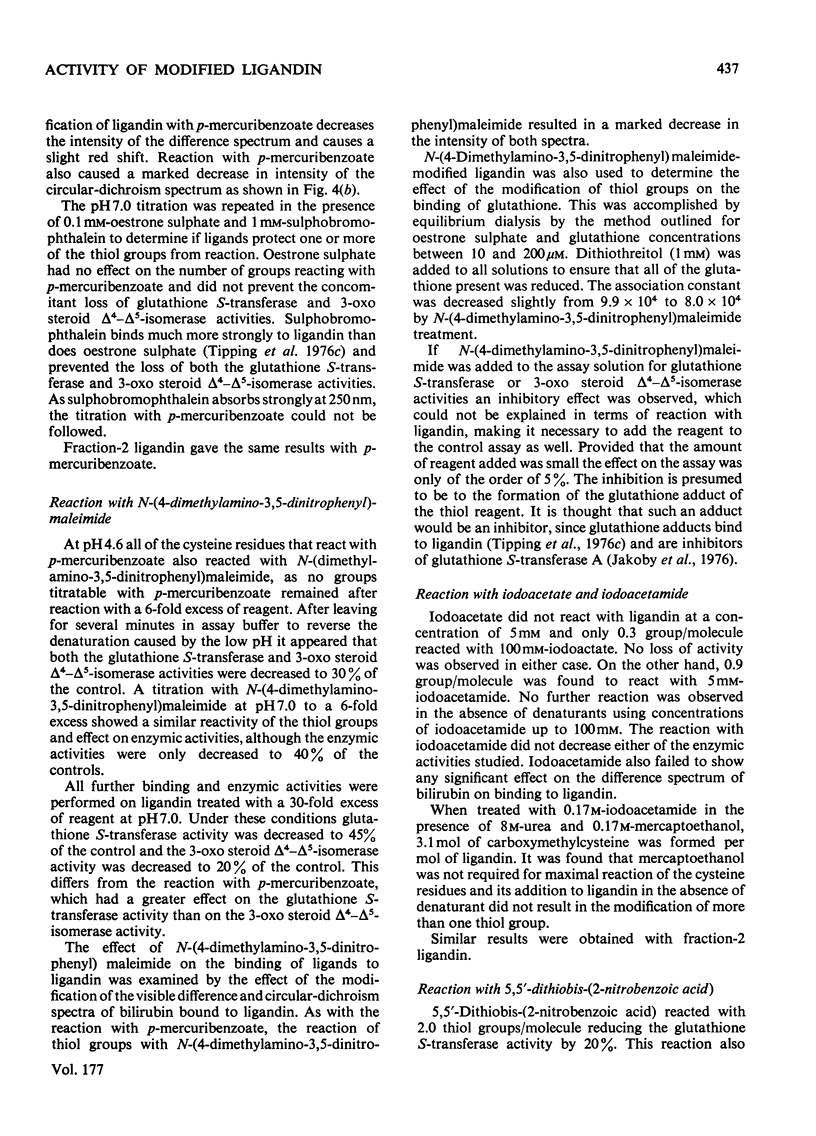
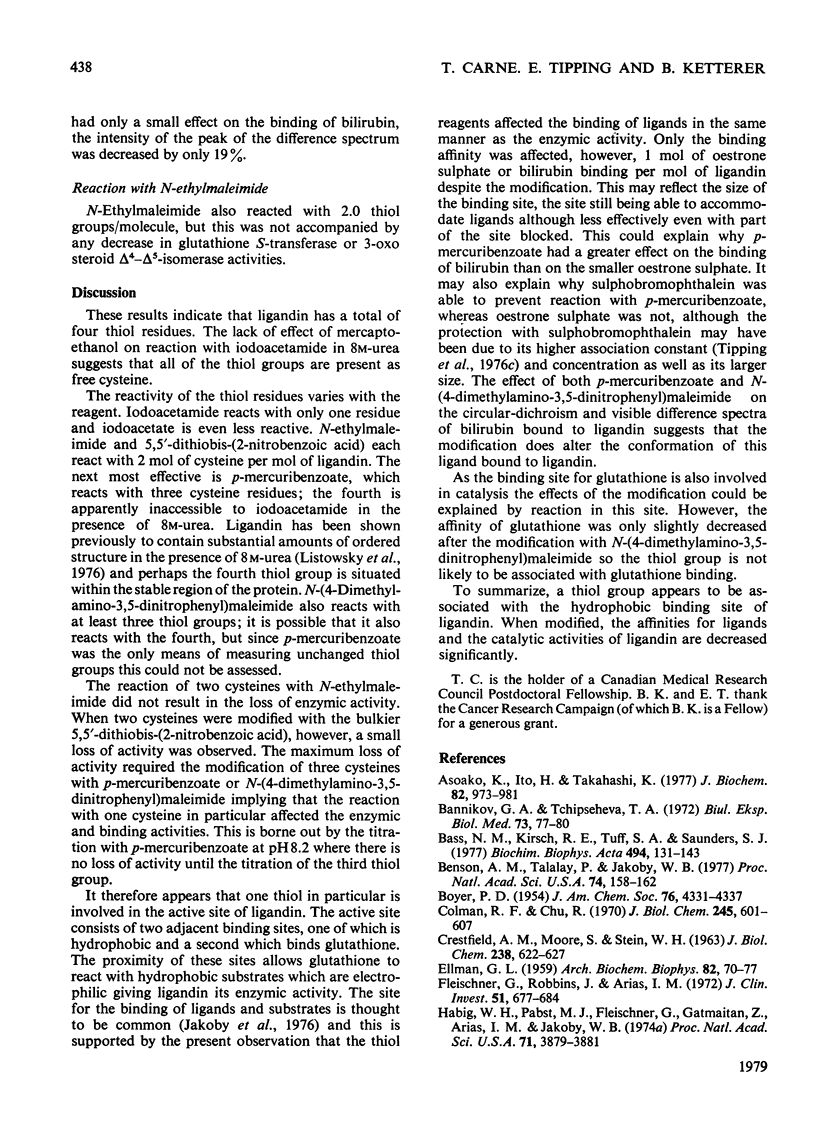
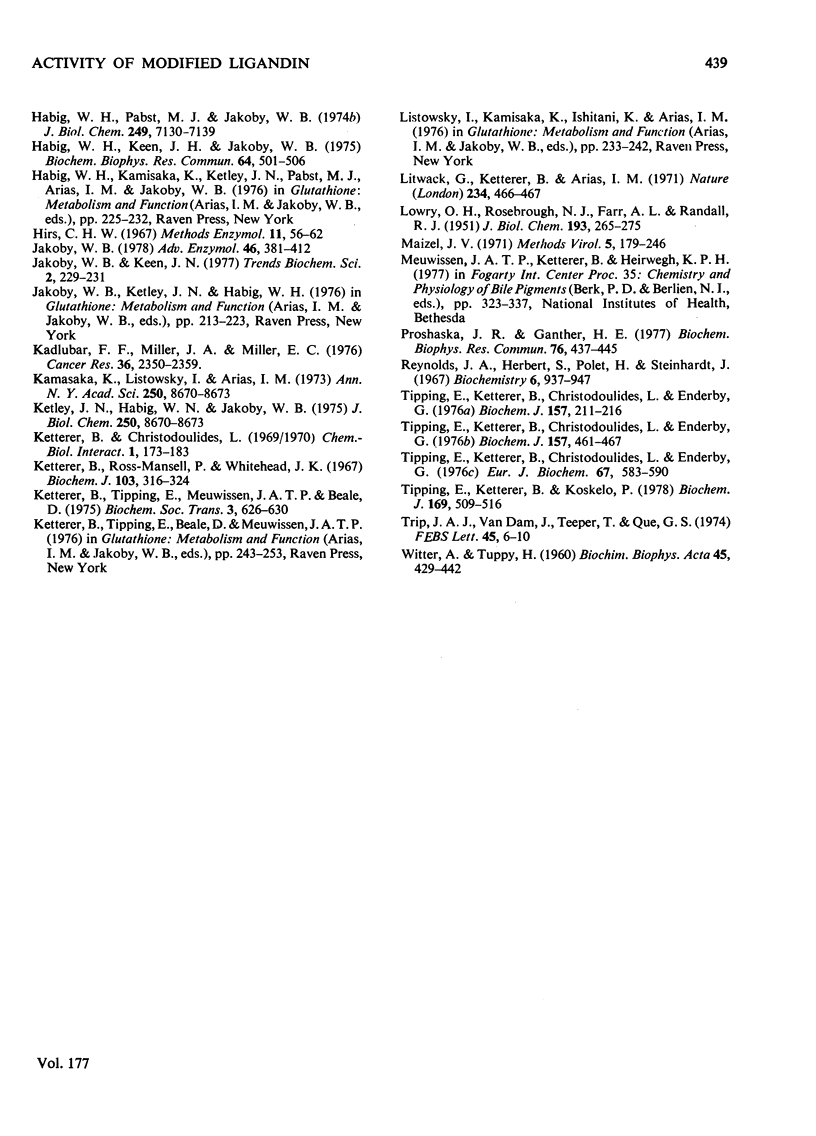
Images in this article
Selected References
These references are in PubMed. This may not be the complete list of references from this article.
- Asaoka K., Ito H., Takahashi K. Monkey glutathione S-aryltransferases. I. Tissue distribution and purification from the liver. J Biochem. 1977 Oct;82(4):973–981. doi: 10.1093/oxfordjournals.jbchem.a131802. [DOI] [PubMed] [Google Scholar]
- Bannikov G. A., Chipysheva T. A. Raspredelenie belka, sviazyvaiushchego azokantserogeny, v organakh krys i myshei. Biull Eksp Biol Med. 1972 Jun;73(6):77–80. [PubMed] [Google Scholar]
- Bass N. M., Kirsch R. E., Tuff S. A., Saunders S. J. Radioimmunoassay of ligandin. Biochim Biophys Acta. 1977 Sep 27;494(1):131–143. doi: 10.1016/0005-2795(77)90141-6. [DOI] [PubMed] [Google Scholar]
- Benson A. M., Talalay P., Keen J. H., Jakoby W. B. Relationship between the soluble glutathione-dependent delta 5-3-ketosteroid isomerase and the glutathione S-transferases of the liver. Proc Natl Acad Sci U S A. 1977 Jan;74(1):158–162. doi: 10.1073/pnas.74.1.158. [DOI] [PMC free article] [PubMed] [Google Scholar]
- CRESTFIELD A. M., MOORE S., STEIN W. H. The preparation and enzymatic hydrolysis of reduced and S-carboxymethylated proteins. J Biol Chem. 1963 Feb;238:622–627. [PubMed] [Google Scholar]
- Colman R. F., Chu R. The role of sulfhydryl groups in the catalytic function of isocitrate dehydrogenase. II. Effect of N-ethylmaleimide on kinetic properties. J Biol Chem. 1970 Feb 10;245(3):601–607. [PubMed] [Google Scholar]
- ELLMAN G. L. Tissue sulfhydryl groups. Arch Biochem Biophys. 1959 May;82(1):70–77. doi: 10.1016/0003-9861(59)90090-6. [DOI] [PubMed] [Google Scholar]
- Fleischner G., Robbins J., Arias I. M. Immunological studies of Y protein. A major cytoplasmic organic anion-binding protein in rat liver. J Clin Invest. 1972 Mar;51(3):677–684. doi: 10.1172/JCI106856. [DOI] [PMC free article] [PubMed] [Google Scholar]
- Habig W. H., Keen J. H., Jakoby W. B. Glutathione S-transferase in the formation of cyanide from organic thiocyantes and as an organic nitrate reductase. Biochem Biophys Res Commun. 1975 May 19;64(2):501–506. doi: 10.1016/0006-291x(75)90349-6. [DOI] [PubMed] [Google Scholar]
- Habig W. H., Pabst M. J., Fleischner G., Gatmaitan Z., Arias I. M., Jakoby W. B. The identity of glutathione S-transferase B with ligandin, a major binding protein of liver. Proc Natl Acad Sci U S A. 1974 Oct;71(10):3879–3882. doi: 10.1073/pnas.71.10.3879. [DOI] [PMC free article] [PubMed] [Google Scholar]
- Habig W. H., Pabst M. J., Jakoby W. B. Glutathione S-transferases. The first enzymatic step in mercapturic acid formation. J Biol Chem. 1974 Nov 25;249(22):7130–7139. [PubMed] [Google Scholar]
- Kadlubar F. F., Miller J. A., Miller E. C. Hepatic metabolism of N-hydroxy-N-methyl-4-aminoazobenzene and other N-hydroxy arylamines to reactive sulfuric acid esters. Cancer Res. 1976 Jul;36(7 Pt 1):2350–2359. [PubMed] [Google Scholar]
- Ketley J. N., Habig W. H., Jakoby W. B. Binding of nonsubstrate ligands to the glutathione S-transferases. J Biol Chem. 1975 Nov 25;250(22):8670–8673. [PubMed] [Google Scholar]
- Ketterer B., Christodoulides L. Two specific azodye-carcinogen-binding proteins of the rat liver. The identity of amino acid residues which bind the azodye. Chem Biol Interact. 1969 Dec;1(2):173–183. doi: 10.1016/0009-2797(69)90005-2. [DOI] [PubMed] [Google Scholar]
- Ketterer B., Ross-Mansell P., Whitehead J. K. The isolation of carcinogen-binding protein from livers of rats given 4-dimethylaminoazobenzene. Biochem J. 1967 May;103(2):316–324. doi: 10.1042/bj1030316. [DOI] [PMC free article] [PubMed] [Google Scholar]
- Ketterer B., Tipping E., Meuwissen J., Beale D. Ligandin. Biochem Soc Trans. 1975;3(5):626–630. doi: 10.1042/bst0030626. [DOI] [PubMed] [Google Scholar]
- LOWRY O. H., ROSEBROUGH N. J., FARR A. L., RANDALL R. J. Protein measurement with the Folin phenol reagent. J Biol Chem. 1951 Nov;193(1):265–275. [PubMed] [Google Scholar]
- Litwack G., Ketterer B., Arias I. M. Ligandin: a hepatic protein which binds steroids, bilirubin, carcinogens and a number of exogenous organic anions. Nature. 1971 Dec 24;234(5330):466–467. doi: 10.1038/234466a0. [DOI] [PubMed] [Google Scholar]
- Prohaska J. R., Ganther H. E. Glutathione peroxidase activity of glutathione-s-transferases purified from rat liver. Biochem Biophys Res Commun. 1976 May 23;76(2):437–445. doi: 10.1016/0006-291x(77)90744-6. [DOI] [PubMed] [Google Scholar]
- Reynolds J. A., Herbert S., Polet H., Steinhardt J. The binding of divers detergent anions to bovine serum albumin. Biochemistry. 1967 Mar;6(3):937–947. doi: 10.1021/bi00855a038. [DOI] [PubMed] [Google Scholar]
- Tipping E., Ketterer B., Christodoulides L., Enderby G. Spectroscopic studies of the binding of bilirubin by ligandin and aminoazo-dye-binding protein A. Biochem J. 1976 Jul 1;157(1):211–216. doi: 10.1042/bj1570211. [DOI] [PMC free article] [PubMed] [Google Scholar]
- Tipping E., Ketterer B., Christodoulides L., Enderby G. The interactions of haem with ligandin and aminoazo-dye-binding protein A. Biochem J. 1976 Aug 1;157(2):461–467. doi: 10.1042/bj1570461. [DOI] [PMC free article] [PubMed] [Google Scholar]
- Tipping E., Ketterer B., Christodoulides L., Enderby G. The non-convalent binding of small molecules by ligandin. Interactions with steroids and their conjugates, fatty acids, bromosulphophthalein carcinogens, glutathione and realted compounds. Eur J Biochem. 1976 Aug 16;67(2):583–590. doi: 10.1111/j.1432-1033.1976.tb10724.x. [DOI] [PubMed] [Google Scholar]
- Tipping E., Ketterer B., Koskelo P. The binding of porphyrins by ligandin. Biochem J. 1978 Mar 1;169(3):509–516. doi: 10.1042/bj1690509. [DOI] [PMC free article] [PubMed] [Google Scholar]
- Trip J. A., van Dam J., Tepper T., Que G. S. A simple procedure for the purification of porcine ligandine (Y-protein). FEBS Lett. 1974 Sep 1;45(1):6–10. doi: 10.1016/0014-5793(74)80797-0. [DOI] [PubMed] [Google Scholar]
- WITTER A., TUPPY H. N-(4-Dimethylamino-3,5-dinitrophenyl)maleimide: a coloured sulfhydryl reagent. Isolation and investigation of cysteine-containing peptides from human and bovine serum albumin. Biochim Biophys Acta. 1960 Dec 18;45:429–442. doi: 10.1016/0006-3002(60)91480-3. [DOI] [PubMed] [Google Scholar]



